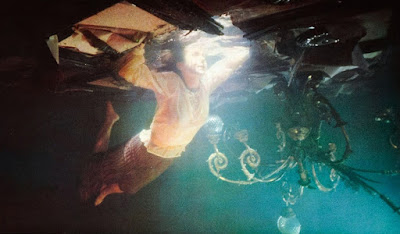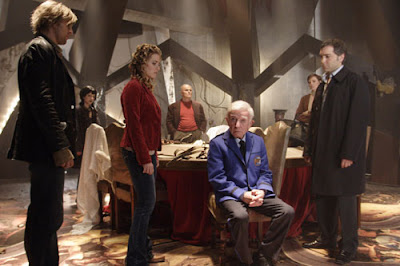 |
| From http://www.qwipster.net/inferno.jpg |
Director: Dario Argento
Screenplay: Dario Argento
Cast: Irene Miracle (as Rose
Elliott); Leigh McCloskey (as Mark Elliott); Eleonora Giorgi (as Sara); Daria
Nicolodi (as Elise Stallone Van Adler); Sacha Pitoëff (as Kazanian)
 Synopsis: Continuing on from Suspiria
(1977), Inferno builds up the
mythology of the Three Mothers, three powerful witches who control the world. Mater
Lachrymarum (The Lady of Tears), Mater Suspiriorum (The Lady of Sighs) and
Mater Tenebrarum (The Lady of Darkness). Mater Suspiriorum, who occupied
Germany, was central to Suspiria, whilst Mater Lachrymarum, who appears briefly
in this film, occupies Rome and is central to the 2007 Argento film Mother of Tears.
Mater Tenebrarum, who rules New York, is central to Inferno, as the information of the Three Mothers is being suppressed
violently through bloody murders. Music student Mark Elliot (McCloskey) travels to the USA after
learning of the distress of his sister Rose Elliot (Miracle) upon discovering the knowledge of the Three Mothers
herself, and finds himself on route to meeting Mater Tenebrarum himself.
Synopsis: Continuing on from Suspiria
(1977), Inferno builds up the
mythology of the Three Mothers, three powerful witches who control the world. Mater
Lachrymarum (The Lady of Tears), Mater Suspiriorum (The Lady of Sighs) and
Mater Tenebrarum (The Lady of Darkness). Mater Suspiriorum, who occupied
Germany, was central to Suspiria, whilst Mater Lachrymarum, who appears briefly
in this film, occupies Rome and is central to the 2007 Argento film Mother of Tears.
Mater Tenebrarum, who rules New York, is central to Inferno, as the information of the Three Mothers is being suppressed
violently through bloody murders. Music student Mark Elliot (McCloskey) travels to the USA after
learning of the distress of his sister Rose Elliot (Miracle) upon discovering the knowledge of the Three Mothers
herself, and finds himself on route to meeting Mater Tenebrarum himself.  |
| From https://myownpersonalhellblog.files.wordpress.com/ 2014/08/inferno-1980-001-irene-miracle-swimming-underwater.jpg?w=1000&h=584 |
Inferno overcomes probably one of the biggest issues with a genre
film in structure. A narratively driven film can fall foul of being merely
dragged along by the plot exposition and having to cover the narrative beats far
too much. They desire to explain everything rather than let you drift through
the film by your own intuition. Inferno's
solution could be bluntly described as dream logic, but it's different from this.
A very simple, concise plot unfolds but both enough is explained to the viewer
whilst plenty isn't, leaving one to travel through the events with enough knowledge
to grasp it but a lot more being discovered alongside the characters. Splitting
the film up into situations following different characters has a pronounced
effect. Everything connects together but the segments unfold as their own
narratives, usually leading to gruesome death. While Mark becomes the lynchpin
to keep it all together, events can unfold without him as well, having a
drastic effect on how the film is watched. Every character introduced not only
stands out but many get central focus for many minutes. As a result you get
plenty of incredibly memorable sequences but also an unpredictable tone.
 |
| From http://www.timeoutdubai.com/images/content /inferno_1980/innerbig/92Inferno_1_innerbig.jpg |
There's plenty of moments in Inferno that stand out, all of which
interconnect under this loose plot completely seamlessly. You being the film
with a standout and elaborate underwater sequence in a submerged room and it
gets better from there, beginning the movie with an appropriate sense of anything
being possible. Since this is a Dario
Argento film the murder sequences are extremely stylish and heightened, but
since Suspiria was a supernatural
horror film, its sequel follows in the unconventional and fantastical mixed
with symbolism from his down-to-earth giallo thrillers. Not only do you have
the grand guinol of the more conventional murder sequences, brutal and
unsettling, but you have sequences like people being savaged by cats or eaten
to death by rats, all of which manages to be both beautiful but utterly foul
and horrific. Unlike other Italian genre films which come off as cheesy, Argento's from this era still sting when
it comes to depicting the deaths and the morbid nature around his films in
general has retained a potency from this.
 |
| From http://screenmusings.org/movie/blu-ray/Inferno/images/Inferno-163.jpg |
With Inferno you have the same heightened tone that is shared with Suspiria, very artificial set around an
elaborate apartment complex where the evil is centred yet fully immersive at
the same time. Genre filmmaking should effortlessly flow. It should use it's narrative
to lead the viewer through a journey, especially if the film is entertainment
first, having the virtue of effecting a viewer's emotions directly if done
well. One of the best virtues of the Italian genre films in their heyday was
their dreamy tones which allowed one to accept the irrational, thus avoiding
distractions of logic in semblance to the real world that break the visage. Cinema
is inherently an unrealistic medium, and unless one attempts to be as realistic
as possible, it should negate the stumbles and falters as much as possible that
take place when exposition and plotting block the steady flow of time. Inferno doesn't attempt to fully
explain what's going on but this is for the better, as a quick witted viewer
can build up enough from what they see onscreen and instead worry about the
labyrinth of turns and abrupt ends that takes place for the characters, as much
a film about travelling through various layers as one finds out the apartment
complex has secret pipes and entrances within itself. Various strands from
petty greed to the Three Mothers mythos interlink tentatively, and as various
memorable casting choices like Nicolodi and Alida Valli pass onscreen, the film is able to work as a tense, eerily
aired horror movie whilst ditching anything that would drag the film down into a
mere plod.
 |
| From http://i263.photobucket.com/albums /ii148/byk66666/vlcsnap-14910590.png |
Technical Detail:
Suspiria was an exceptional film just for how its use of colour and
lighting took the viewer into a supernatural world, but Inferno's aesthetic manages to go even further in some ways by
becoming even more coloured and bold in its look. This would one of the last
things the great director Mario Bava worked
on before his death, behind the optical and visual effects, and in many ways,
as a tip of the hat from Argento to
the innovator who helped build the Italian genre industry, this film reflects
the bold colours of his work like Blood
and Black Lace (1964) incredibly. Like Suspiria,
terror is not just to be found in the darkness but in colour itself, at their
brightest and lurid during the most unsettling incidents. With Argento's work during his golden period,
the colour saturation (or lack of colour as in Tenebrae (1981) fully envelops and becomes one with the haunted
moods of his films.
Instead of Goblin, the music changed for this film, with Keith Emerson from the prog band Emerson, Lake and Palmer as composer. That band's an acquired
taste, but Emerson's film scoring
career is a cult following still waiting to happen - alongside Inferno you have the notorious anime
blockbuster Harmagedon (1983), Nighthawks (1981) with Sylvester Stallone and Rutger Hauer, and Godzilla: Final Wars (2004) amongst other films. While many of
these films aren't available in the UK, it's not surprising that prog rock fans
can buy a compilation of Emerson's
scores, the one for Inferno a great
addition to Argento's musical canon by
itself. Far more hysterical and on the cusp of absurdity with its choral
chanting than the Goblin score for Suspiria, it helps push the
irrationality of the film further with its alarmed, drastic tone.
 |
| From https://www.acheronbooks.com/img/cms /Inferno/largeinfernobluray8x.jpg |
Abstract Spectrum: Fantastique/Psychotronic
Abstract Rating (High/Medium/Low/None): High
Inferno is Argento's most
unconventional film, more than even Suspiria,
rejecting the plot heavy narratives that his giallos tend to have completely. It
follows a logic of its own that drifts between various characters and never
gives priority over any specific one, Mark Elliot merely a grounded figure for
the events happening to circle around. It's a filmic world where one can go to
a library in Rome and, going downstairs, find oneself in an alchemist's laboratory.
It's a film where events such as a total eclipse suddenly happens only to
disappear; I don't complain about this sudden inclusion and abrupt end to such
sights because the canvas of the film allows the moment to soak in regardless. So
much more terrifying in films for me, like in Suspiria, is irrationality, that deaths can happen abruptly or
events happen without being signposted, and as this desired template stands, Inferno is one of the strongest
examples.
 |
| From http://photos.bravenet.com/272/478/925/3/E829847AD5.jpg |
Personal Opinion:
Finishing off the Halloween 31 For 31 here with this the
31st entry, it's been a lot of written blog pages but aside from the fun of it,
is there anything worth mentioning about it as a whole? Like the years before,
once this is over some films I even praised highly will disappear from memory,
not because they'll suddenly become bad but because my tastes are very
selective. Some will grow in memory with the possibility of ones I gave less
than stellar reviews of growing in stature. Others were too fun to even care
about this. But there's a certain type of cinema that appeals to me, something
that can sometimes be directly linked to a dream logic, which are very loose
with structure plotting allowing the viewer to fill in the space, or merely
have a unique personality to them of their own.
Inferno is one of the my favourite films. I don't care if the
plot's ridiculous, makes no sense rationally or that like Suspiria another building of evil gets set on fire because of an
accident at the end, far and away more appealing for this reason than countless
horror films that are so heavily plotted you're stuck sitting through
exposition scenes. The mythos built here helps give the film a greater
atmosphere, building up a background that fills in what is not dealt with;
unfortunately it seems, yet to dare see it, that Mother of Tears ruined the trilogy, but what is created here is a
lot better than other horror films. With this film I'm not thinking of its
logic or letting the world it creates become ruined by over thinking about it, instead
an experience where, unlike a rollercoaster, everything presented onscreen is
felt. Every death is painful, every jolt is startling, but the moments of
quietness are just as effective. When the power goes on and off in one scene,
causing a classic piece of music on a record player to jump, it lifts the hairs
on the back of my neck, and more absurd scenes like death by rats have a phantasmagoric
ickiness to them that's still effecting. Rather than coming away from Inferno as another horror film padded
out with attempts to rationalise everything, the completely lack of this adds
to its mystique, leaving it at the end with the same level of intensity felt as
with Suspiria. Together the duo are
incredible examples of Italian horror cinema, but I confess I may love Inferno the most.





































